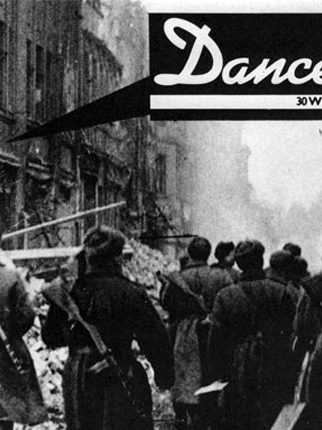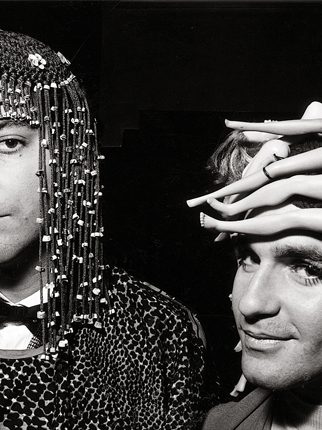L.A. Nightlife Gone: Does Your Mama Know? 1992–2003
Whoever said, “Nothing good ever happens after 2am” obviously never experienced Does Your Mama Know.

“A few days later, I saw a local news report on L.A. after-hours clubs, raves and drugs, and I knew they were trying to get us involved in their negative hype.”
Tony Largo—the proprietor and resident DJ—was playing Deee-Lite’s “Pussycat Meow,” using two copies of the a cappella, cutting them back and forth. There were no beats playing, just Lady Miss Kier purring like a cat and laughing maniacally. The crowd was going wild with anticipation. When he finally dropped the beats again after several minutes, the room erupted.
The place was packed, and behind us, close to the main dancefloor, the bar had just opened. We were drinking like it was the last booze on earth and we had no idea when this party would end. I remember feeling that the outside world meant nothing to us in that moment. We were home.
Does Your Mama Know? was a weekly after-hours club that ran on Saturday nights from 1992 until 2003. Its home for many years was the infamous Sunset Strip rock venue the Coconut Teaszer. If ever there was a legendary club in L.A., DYMK was it.
The Teaszer would finish their Saturday night rock shows at 2am Sunday morning, and then Largo and his crew would set up their sound, decorations and lights; they would have the doors ready to open by 3am. There was always a line of people waiting to get in. [One time, I was behind Carson Daly waiting to get in; he stood in line, too. —ED]
“I just remember 3am, when we opened, never coming soon enough on a Saturday night,” remembers Marques Wyatt, who was one of the resident DJs for years before he started his Deep brand. “I always did another gig until 2:30, called High Society, which I considered a warmup for DYMK. When I shopped for records, I always had our DYMK faithful in mind—‘Oh, they’re going to love this one,’ is what I would say to myself.”
“Grace Jones would have two men attached to her with chains and would walk in, screaming and yelling with wild eyes. Then she would get on the floor and dance with everybody else.”
“I remember when Marques and Tony would tell me what time I should start DJing, and I was in shock with the starting time,” says Louie Vega, who played there several times during the ‘90s. “Then I would arrive, and the place was packed with all sorts of people! It was dark, sexy, cool, diverse, and the music was awesome! You also had great DJs like Tony Largo, Marques Wyatt and others from L.A. giving you an array of sounds and had full control of the crowds that would come to hear their musical journey. Then, guys like me were the icing on the cake, bringing our sound to the table. Long sets, too… hours and hours!”
A Los Angeles native, Largo started DJing at age 16 in the late ‘70s, playing disco and R&B dance music. Around 1983, he went to New York and came back with a new sound called “house.”


“Back then, I was playing as a resident at clubs like Fantasia and Excess, and regular guest spots at Circus Disco and Arena,” Largo adds. “Around 1988, I played at various underground clubs around the city—events like Bram and Steve’s Open House, Ana’s Playhouse, King, Parliament, Candelabra (the precursor to DYMK) and Maxx on Sunday afternoons.”
A few years later, he found his way to the Coconut Teaszer, and Does Your Mama Know? began to carve its name into L.A. club culture history.
The club featured all walks of L.A. life: house-heads, people from around the world, gay people and straight people, dancers, partiers, models, waiters, actors, hospitality workers—you name it. The age limit was 18, but most of the crowd was age 25–35 and up. A lot of expats from New York and Chicago were regulars, since this was one of the few weekly clubs in L.A. that featured the kind of music their respective cities had created.
“Playing at DYMK remains atop my list of DJing experiences. It was a perfect storm… When you entered the Coconut Teaszer, it was sort of like being in a dark, warm womb, and we were its house babies.”
DYMK was not on the radar of regular society. You had to know someone who knew someone who knew about it. Sure, you could find flyers at some L.A. record stores like Beat Non Stop, Street Sounds, WAX, DMC or Aaron’s, but if you didn’t know those places, you probably wouldn’t even know DYMK was going on. Maybe if you were driving down Sunset at 3am on a Sunday and saw the huge line winding down the block, you might have been curious enough to stop and discover it. Tony Largo, and everyone else involved, always knew that the people who really wanted it would find it.
Sometimes the wrong people would try to infiltrate the club. The news media tried to get in, but Largo and crew were well aware that they didn’t want the media inside.
“One time, a news crew showed up and tried to get in, saying that they were going to film us, thinking we would be happy to be on the news,” says Largo, laughing. “I told them they couldn’t film inside. They seemed shocked that we wouldn’t let them in. I said they could film outside on the front sidewalk all they wanted. Then, a few days later, I saw a local news report on L.A. after-hours clubs, raves and drugs, and I knew they were trying to get us involved in their negative hype; but I wasn’t having any of that shit.”
DYMK was no spot for publicity; no Hollywood-style fakery was allowed. This was the L.A. underground, in club form. But in Los Angeles, even the underground events can have celebrity sightings.

“I remember DJing, doing my thang, rockin’ DYMK, and who was dancing the night away with her friend? The incredible Grace Jones!” Vega recalls. “She was in it and feelin’ it!”
“[Jones] would have two men attached to her with chains and would walk in, screaming and yelling with wild eyes,” Largo adds. “Then she would get on the floor and dance with everybody else.”
Does Your Mama Know? had no VIP room. Everyone mixed, mingled and danced in the same space.
I was fortunate enough to play there a few times, thanks to my affiliation with DJ and L.A. legend Terence Toy. One night around 3:30 am, toward the end of my opening set, a hushed whisper echoed throughout the room: “It’s Janet… Janet is here!” I noticed a woman disguised in a hooded top, dancing with a few friends on the stairs by the booth. In the darkness of the club, I couldn’t tell if it was indeed Janet Jackson.
Minutes later, a short African American woman stood next to me behind the decks; she reached around and lightly patted my crotch while giving me a big smile and an approving thumbs-up. I looked at her in disbelief and thought to myself, “That’s fucking Missy Elliott.”
It wasn’t sexual; in her own unique, non-verbal way, she told me she approved of the music and the vibe. Then she went to join her friends by the stairs. They danced for a while and later disappeared into the crisp, early, West Hollywood morning. Later, we found out that the group was composed of Janet Jackson, Missy Elliot, Ciara and Eve, along with some others.

Besides the music, the DJs and the crowd, the sound system was one of the stars of the club. The sound they brought in just for DYMK was incredible in that venue, and it was perfectly tuned to the low ceilings and dense, angular floor plan.

A big part of this sound experience was the cornerstone Urei mixer, Largo’s ear for high-quality sound, and his longtime sound engineer, Benny Castro.
“Benny Castro deserves a lot of credit,” Largo says. “Without him working the EQs, crossovers and range expanders, it would not have been the quality that we wanted. I was just a DJ, and since he handled the sound so well, I was able to focus on the music 100 percent.”
Many clubs, raves and underground parties featured some sort of house music around the city, but this was the place to consistently hear the true deep house and garage sounds. Soul and vocals, funk, Latin and disco vibes were always present, along with tough, innovative tracks that were consistently moving the crowd.
“There were so many tracks that were broken at that club by either Tony or me,” Wyatt remembers. “A couple standouts for me are the Underground Network remix of ‘Beautiful People’ by Barbara Tucker, ‘My Desire’ by Nu Colours (Masters at Work Remix), Armand Van Helden ft. Roland Clark ‘Flowerz,’ ‘God Made Me Funky’ by Mike Dunn, ‘Heaven Knows’ by Angel Moraes, ‘It’s Just Another Groove’ by the Mighty Dub Katz, ‘Big Love’ by Pete Heller, ‘House Music’ by Eddie Amador, ‘Love Commandments’ by Giselle Jackson, ‘The Dream’ by Deep Dish, ‘I Know a Place’ by Sound of One, ‘Been a Long Time’ by the Fog… to name a few.”
Vega recalls, “Some specific tracks that went over well: ‘I Can’t Get No Sleep’ by MAW featuring India, ‘Coming on Strong’ (Spagatoni Mix) by Desiya, ‘The Pressure’ (Frankie Knuckles Remix) by Sounds of Blackness, ‘I’ll Be Your Friend’ (David Morales Mix) by Robert Owens and ‘I Called You’ by Lil Louis. There were many!”
The L.A. house music elite were residents and regulars for years. For many years, Largo and Wyatt shared resident duties early on, and over the course of the club’s run, Terence Toy and Tony Powell played regularly for many years, along with Largo. Other notable regulars were Eddie X, Iggy, Len Sobeck (Iggy and Len are remembered fondly by those who knew them; both passed on years ago), Fabian, Miguel Plasencia, Juan Nunez, Orlando, Teddy Q, Rafael Canton, Edgar, Wayne Lyons, Jerry Flores, Lamech, Danny Zee, Lonnie, Terence Flores, and many others all kept the quality going every week over the club’s 10-year run.
Some of the biggest international names in house played DYMK, too—people like Frankie Knuckles, Tony Humphries, Vega, Wyatt, CJ Mackintosh, Boris Dlugosch, Angel Moreas, Benji Candelario, Disciple, JoJo Flores, Farley and Heller, Frankie Feliciano, Terry Hunter, Steve “Silk” Hurley, Benji Candelario, David Harness, Mark Grant, David Alvarado, Mijangos, Eddie Amador, Kerri Chandler, Byron Stingly and Danny Tenaglia, among others. Even respected New York sound system designer DJ Shorty played there a couple of times.


DYMK was the best club I’ve experienced. It wasn’t about fancy surroundings or hype; it was about music—and stamina. Sometimes when we would leave after closing, eyes squinting from the bright, searing sunlight, we would see people walking to a nearby church service. Little did they know that we had already worshipped our gods—the gods of house music. They had blessed us all night long, we were fulfilled, we were tired from dancing for hours, and we couldn’t wait for the next Saturday to do it all over again.
DYMK continued for two years at the Catch One Disco after the Teaszer closed. You can still catch Largo and many of the DYMK DJs at gigs around L.A. and beyond. Ask anybody who experienced the club during its run, and you will hear amazing tales of how it changed their lives. Its legacy will always live on.

Follow Tony Largo on Facebook | Mixcloud | SoundCloud





